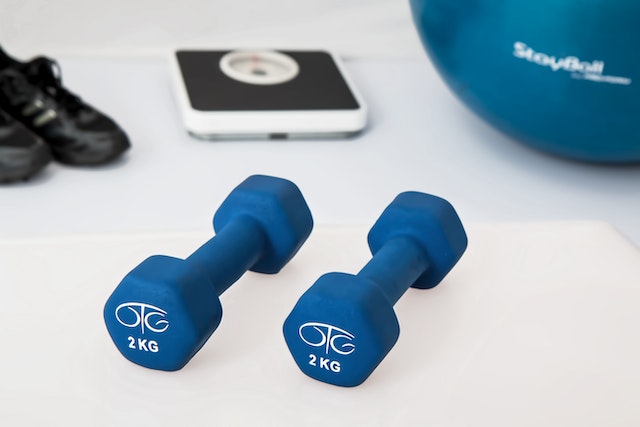Laser sharp customised optimal well-being is your happy ending rewarding journey!
If you have a few pounds or stones to lose the challenging road in this journey is to lose extra weight (specifically targeting the dangerous visceral fat tissue), maintain lean muscle mass and a healthy weight.
I know, you all will agree with this.
Everyone has renewed motivation to get back to exercising or has new goals of shedding those extra pounds!
However,
Did you know that effective exercise starts much before you start sweating and does not end with your last exercise?
Want to know, how?
Also, want effective weight loss tips?
Let us understand it from the basics to avoid weight loss mistakes.
Introduction
Overweight and obesity represents a major health problem worldwide.
Research shows that obesity is a major risk factor for diabetes, blood-pressure, heart disease, disturbed sleep, some forms of cancer, and musculoskeletal disorders. [1,2]
Most of us struggle to shed the excess weight that we carry. The factors responsible for this are sedentary lifestyle, genetics, lack of exercise, underlying medical conditions, and poor diet choices (high-calorie, low-fiber, junk food).
A customised lifestyle comprising adequate exercise for your goals, good sleep habits, and a nutritious diet go a long way to help shed that excess weight.
Are you exercising but not satisfied with your progress in achieving your goal of healthy body weight?
You need to avoid weight loss mistakes!
Learn more about how Jazz helped Dr Christian NHS, Olivia, Beverley, W. T. Police officer, Emma, Mark, and Alesia to lose weight naturally.
BOOK YOUR FREE CONSULTATION NOW!Why exercise is crucial for weight loss?
The main cause of obesity is an imbalance between calories consumed and calories expended (lack of exercise), although genetic factors, certain diseases and medications are also responsible. [2]
If you regularly eat or drink more calories than you need, you’ll gain weight!
When you exercise, you increase the number of calories your body uses for energy.
Exercising regularly (combined with reducing the calories you eat), creates a calorie deficit or a negative energy balance that results in weight loss. [3]
The link between exercise and calorie burning
A calorie deficit is required for weight loss.
This means you need to burn more calories than you consume.
Exercise burns calories, expends energy, uses fat as a fuel and thus reduces fat and defends against weight gain. [4]
Moreover, exercise can continue to expend energy even after a person stops exercising. [5]
Dangers of focusing on weight loss without exercising

Research shows that losing excess weight by going on crash diets (reducing calorie intake) is unhealthy – more of the weight loss is from lean body mass [6] – this further damages your body. Also, research shows that you tend to regain the weight after losing it. [7]
Most people want to lose weight without exercising – “no time” is the usual excuse to not exercise!
Note the benefits of including exercise in your weight loss programme as compared to losing weight by just dieting. [6,8]
- Favorable effect on body fat distribution (melting fat), with a reduced waist-to-hip ratio
- Better results in maintaining the weight loss
- Improved levels of cardio respiratory fitness
- Maximum weight loss – and all in a healthy way
On the minus side, lack of exercise (being sedentary) results in reduced muscle mass, decreased bone density, causes fatigue, and leads to obesity, diabetes and heart disease.[1]
Your goal is not just to lose weight, but also maintain a healthy body weight!
Avoid common weight loss mistakes!
So, resolve to include regular exercise in your weight-loss plan – it is not only more successful, but also healthier.
To get advice on proper weight loss tips: BOOK YOUR FREE CONSULTATION NOW!
Dos for Maximum Weight Loss Results
1. Do Make a Plan
Answer these questions before you make a plan:
- What is my weight goal? (Have a timeline and ensure the goal is realistic)
- What will be my diet and how to do correct calorie counting?
- What other healthy habits do I need to embrace (diet, sleep, stress management)?
- When and for how long will I exercise?
- What type of exercises will I do?
Want to feel again fit, toned and happy and show off some lean muscles?
BOOK YOUR FREE CONSULTATION NOW!2. Do Keep it Consistent
The key is to exercise for your goals – be faithful and consistent to your weight loss plan.
When are tempted to give up, focus on the benefits you will reap from being healthier.
3. Do Mix it Up
A combination of cardio training (aerobic exercise) and strength training (resistance training) is recommended but, you need to get the balance right.
Each type has its own benefits and works on different parts of your body.
Plus, it is more fun and less monotonous to have variety in your exercise routine!
4. Do Strength training
Strength training uses resistance to build muscle, strength, and endurance.
It is also called resistance training.
Examples include using your own body weight (body conditioning), lifting weights, doing repetitions on weight machines, push-ups, squats, sit-ups, Pilates, climbing stairs, walking or running on hills or using a machine to simulate an incline.
Remember – muscles burn more calories than fat.
Research shows that strength training helps you to build more muscle, speed up your metabolism, burn more fat, improve your movement control, enhance your physical and cognitive performance. [9,10]
So, you don’t just lose weight, you become stronger too!
It is recommended to do some sort of strength training for an hour 3-5 times per week (not daily).
5. Do Cardio
Cardiovascular exercise (cardio or aerobic exercise) increases your heart rate and makes your lungs work harder than normal.
Thus, you lose weight by burning calories.
NHS doctors recommend at least 30 minutes per day of cardiovascular exercise and it can be done daily.
6. Do Get Enough Sleep
Present-day lifestyles and technologies are often not conducive to adequate sleep at times when the internal physiological clock is promoting it (for example, late-night screen time, shift work, and nocturnal social activities). [11]
 Lack of sleep, insufficient sleep, and/or sleeping at the wrong times affect the “hunger hormones” (ghrelin, leptin), causing your appetite for food to be stimulated.
Lack of sleep, insufficient sleep, and/or sleeping at the wrong times affect the “hunger hormones” (ghrelin, leptin), causing your appetite for food to be stimulated.
You thus tend to overeat and put on weight. [11]
Improved sleep quality and sufficient sleeping hours have been found to contribute to weight loss in obese persons. [12]
So, sleep on time and sleep enough hours.
Most medical experts recommend sleeping for at least 7 hours every night.
7. Do Pay Attention to Customised Nutrition for your body’s particularities
Excessive calorie intake is a big culprit for weight gain.
To reap the maximum weight loss through exercise, it is important to make changes to your diet too.
 Customised meal planning for your body transformation goals is very important.
Customised meal planning for your body transformation goals is very important.
Research shows that is is best to eliminate or at least avoid eating processed foods, fast foods, refined starches (white bread, white rice), and foods high in sugar and saturated and trans-fatty acids.
Opt for natural foods such as fruits, vegetables, nuts, lean protein, and whole grains, which are healthier with lower calorie content and high fiber.
Use healthy fats (polyunsaturated and monounsaturated fats).
Based on your gender, age, weight, muscle-to-body fat ratio, and existing health issues, your trainer will advise you personalised nutrition plan for the type of body transformation you want.
BOOK YOUR FREE CONSULTATION NOW!
8. Do Manage Stress
Did you know that research shows that stress stimulates the “hunger hormones” (leptin, ghrelin), which makes you overeat and gain weight [13]?
But,
Did you know that when you are stressed you also tend to consume poor food, sleep poorly, and are less motivated to exercise?
I take clients though a special process so you will become better equipped to manage your stress at home and work, use adequate sleep, learn good time management practices, exercises you need to burn fat, yoga, meditation, and relaxation techniques.
Don’ts for Maximum Weight Loss Results
1. Don’t Overdo It
In an attempt to burn more calories, you might be tempted to “overdo” exercise or “overexert” (indulge in excessive intensity and/or volume of exercise).
This is neither effective nor healthy.
Studies show excessive exercise is unsustainable in the long term for most people, may lead to stress and also negatively impact your hormones which help regulate body functions. [14]
2. Don’t Skip Warm-Ups and Cool-Downs
Warm-ups and cool-downs generally involve doing your exercise at a slower pace and reduced intensity.
They give your heart and blood vessels a chance to ease into — and out of — an exercise session.
Warming up before your workout increases your heart rate and blood flow, enabling more oxygen to reach your muscles.
It also improves the efficiency of movement by activating the connections between nerves and muscles.
Research shows that it also helps reduce muscle soreness and lessen your risk of injury. [15]
Cooling down after your workout allows for a gradual recovery of pre-exercise heart rate and blood flow. [16]
Many people skip warm-ups and cool-downs to save time – this is a big no-no!
3. Don’t Rely on Exercise Alone
Studies show a greater weight loss is achieved through a combination of diet and exercise as compared to exercise alone [17].
The most effective approach to achieving significant weight loss includes a combination of diet, exercise, and behavioral strategies. [2,17]
4. Don’t Ignore Form and Technique
Form and technique refer to the correct way to perform an exercise.
This includes body positioning, correct exercise approach and succession for your goals, targeting the right muscles, and using the right range of motion.
For example, if you ride a bike in a hunched posture, you will be unable to fill your lungs with breath, the supply of oxygen and nutrients to your muscles will be reduced, and you will get fatigued faster.
If exercises are done incorrectly, you will put undue strain on your muscles and joints, which can lead to pain and even serious injury.
5. Don’t Neglect Flexibility
Flexibility refers to the ability of our joints to move through their entire range of motion.
Flexibility training means much more than just stretching during warm-up and cool-down.
Flexibility training is integral to weight loss.
It helps create the required balance for our muscle groups during exercise.
Increasing flexibility will shorten recovery time, reduce the risk of injury and make the most of the workout by burning calories leading to maximum weight loss.
6. Don’t Lead a Sedentary Lifestyle
It is not enough to merely exercise and diet.
Ask yourself the following question… 
What would be your sustainable way to help you embrace body transformation long lasting healthy habits?
Of course – to a very large extent we do what we prioritise as being on your higher on our life values.
We can all eliminate or minimise the time spent routinely sitting in front of the T.V. or computer and lying down during the day.
Conclusion
Research shows that the most effective approach to achieving sustainable weight loss includes a combination of customised nutrition diet plan, smart exercise for your goals, and appropriate lifestyle changes. [2,17]
Studies show that the appropriate exercise programme should ideally combine a large negative energy balance, long-term adherence, and beneficial effects on health and well-being. [18]
Are you feeling stuck in your weight loss journey?
If your answer is Yes, remember there is no “one size fits all” solution to sustainable and healthy weight loss.
Your body transformation goals needs the right support – this is customised meal planning and tailor-made exercises.
Consult Jazz for the best customised exercise programme for your goals, and a personalised nutrition diet plan that will:
- Take your gender, age, weight, muscle-to-body fat ratio, existing health issues, dietary preferences, food sensitivities, allergies, lifestyle, and specific needs into account
- Ensure enough calories are burnt during each session to support and sustain healthy weight loss without causing damage or placing you at any significant risk.
- Help you lose abdominal fat, enjoy a toned and strong physique and completely transform your body in balance.
Who is Jazz Alessi?
Jazz Alessi is an experienced specialist personal trainer and expert nutritionist in London lecturing at LSE Athletic Division and international law firm Cameron McKenna who has transformed the lives of people suffering from weight issues in London through his complete body transformation programme and sustainable weight loss programme.
Jazz will professionally support you and create a customised programme and a personalised nutrition diet plan to successfully help you reach your ideal healthy body weight and body shape results.
Keen to get started?
BOOK YOUR FREE CONSULTATION NOW!
FAQ
1. Can you lose weight without exercise?
You can lose weight without exercise by calorie restriction (low-calorie diets, fasting, crash diets), but these diets are generally very unhealthy, and you tend to regain the lost weight. The health benefits of exercise extend beyond losing weight; you build healthy muscle mass, reduce fat, improve fitness, reduce the risk of metabolic syndrome and boost your mental health (foods alone cannot do this). Bottomline – You can lose weight without exercising, but you cannot be healthy without exercising.
2. How long should I exercise for maximum weight-loss results?
The U.K. National Health Service Guidelines recommend each week, at least 150 minutes of moderate-intensity activity, 75 minutes of vigorous activity, or a mixture of both, and strength exercises on at least two days a week. My rule of thumb is 2 – 3 days of training / week is for maintenance and 4 – 5 days week to help you achieve predictable, consistent and strong weight loss results.
3. What is the best time of day to exercise for weight loss?
Human studies on exercise timing have been contradictory. Some studies indicate women burn more fat by exercising in the morning compared to men, who burn more fat at night. More important is that you exercise consistently at a time that is convenient to you (works best with your schedule). Avoid exercise within 3 hours of sleep.
4. How do I know if I am overdoing it with exercise?
You are “overdoing” it with exercise if you have unacceptable levels of body tension, pain or pain lasting for more than 24 hours, suffer from soft tissue injuries, broken bones, sprained joints, fractures, feel fatigued, need longer periods of rest, feel depressed, anxious, irritable, have mood swings, or have trouble sleeping. Your trainer will advise you on scaling down the exercise and/or resting for a few days or weeks to aid recovery.
5. Is it better to focus on cardio or strength training for weight loss?
To achieve weight loss and maintain it, you need to burn calories and build muscle mass. So, for optimal benefits, you should incorporate both cardio and strength training into your exercise routine. If you suffer from back pain, back injury, knee injury you need to rehabilitate first then combine customised training with a bespoke nutrition programme.
References
1. Duran, A.T.; Romero, E.; Diaz, K.M. Is Sedentary Behavior a Novel Risk Factor for Cardiovascular Disease? Current cardiology reports 2022, 24, 393-403, doi:https://pubmed.ncbi.nlm.nih.gov/35182312/.
2. Fock, K.M.; Khoo, J. Diet and exercise in management of obesity and overweight. J Gastroenterol Hepatol 2013, 28 Suppl 4, 59-63, doi:https://pubmed.ncbi.nlm.nih.gov/24251706/.
3. Swift, D.L.; McGee, J.E.; Earnest, C.P.; Carlisle, E.; Nygard, M.; Johannsen, N.M. The Effects of Exercise and Physical Activity on Weight Loss and Maintenance. Prog Cardiovasc Dis 2018, 61, 206-213, doi:https://pubmed.ncbi.nlm.nih.gov/30003901/.
4. Kotz, C.M.; Perez-Leighton, C.E.; Teske, J.A.; Billington, C.J. Spontaneous Physical Activity Defends Against Obesity. Curr Obes Rep 2017, 6, 362-370, doi:https://pubmed.ncbi.nlm.nih.gov/29101738/.
5. Zelasko, C.J. Exercise for weight loss: what are the facts? J Am Diet Assoc 1995, 95, 1414-1417, doi:https://pubmed.ncbi.nlm.nih.gov/7594144/.
6. Blair, S.N. Evidence for success of exercise in weight loss and control. Ann Intern Med 1993, 119, 702-706, doi:https://pubmed.ncbi.nlm.nih.gov/8363201/.
7. Shai, I.; Stampfer, M.J. Weight-loss diets–can you keep it off? Am J Clin Nutr 2008, 88, 1185-1186, doi:https://pubmed.ncbi.nlm.nih.gov/18996849/.
8. Lavie, C.J.; Ozemek, C.; Carbone, S.; Katzmarzyk, P.T.; Blair, S.N. Sedentary Behavior, Exercise, and Cardiovascular Health. Circ Res 2019, 124, 799-815, doi:https://pubmed.ncbi.nlm.nih.gov/30817262/.
9. Ina, S.; Travis, T.; Brandon, S.S. Resistance Training and Weight Management: Rationale and Efficacy. Weight Management 2022, Ch. 8, doi:https://www.intechopen.com/chapters/79915.
10. Westcott, W.L. Resistance training is medicine: effects of strength training on health. Curr Sports Med Rep 2012, 11, 209-216, doi:https://pubmed.ncbi.nlm.nih.gov/22777332/.
11. Chaput, J.P.; McHill, A.W.; Cox, R.C.; Broussard, J.L.; Dutil, C.; da Costa, B.G.G.; Sampasa-Kanyinga, H.; Wright, K.P., Jr. The role of insufficient sleep and circadian misalignment in obesity. Nat Rev Endocrinol 2023, 19, 82-97, doi:https://pubmed.ncbi.nlm.nih.gov/36280789/.
12. Thomson, C.A.; Morrow, K.L.; Flatt, S.W.; Wertheim, B.C.; Perfect, M.M.; Ravia, J.J.; Sherwood, N.E.; Karanja, N.; Rock, C.L. Relationship between sleep quality and quantity and weight loss in women participating in a weight-loss intervention trial. Obesity (Silver Spring) 2012, 20, 1419-1425, doi:https://pubmed.ncbi.nlm.nih.gov/22402738/.
13. Tomiyama, A.J. Stress and Obesity. Annu Rev Psychol 2019, 70, 703-718, doi:https://pubmed.ncbi.nlm.nih.gov/29927688/.
14. Hackney, A.C.; Lane, A.R. Exercise and the Regulation of Endocrine Hormones. Prog Mol Biol Transl Sci 2015, 135, 293-311, doi:https://pubmed.ncbi.nlm.nih.gov/26477919/.
15. McGowan, C.J.; Pyne, D.B.; Thompson, K.G.; Rattray, B. Warm-Up Strategies for Sport and Exercise: Mechanisms and Applications. Sports Med 2015, 45, 1523-1546, doi:https://pubmed.ncbi.nlm.nih.gov/26400696/.
16. Van Hooren, B.; Peake, J.M. Do We Need a Cool-Down After Exercise? A Narrative Review of the Psychophysiological Effects and the Effects on Performance, Injuries and the Long-Term Adaptive Response. Sports Med 2018, 48, 1575-1595, doi:https://pubmed.ncbi.nlm.nih.gov/29663142/.
17. Celik, O.; Yildiz, B.O. Obesity and physical exercise. Minerva Endocrinol (Torino) 2021, 46, 131-144, doi:https://pubmed.ncbi.nlm.nih.gov/33213121/.
18. Petridou, A.; Siopi, A.; Mougios, V. Exercise in the management of obesity. Metabolism 2019, 92, 163-169, doi:https://pubmed.ncbi.nlm.nih.gov/30385379/.



